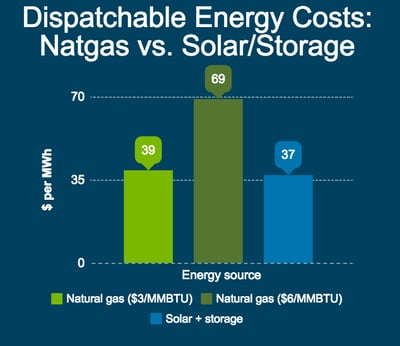Renewable energy has surged to become the fastest growing source of electricity in the United States today. Grid-scale wind and solar made up 67% of new capacity additions in 2015, and wind and solar are projected to make up a similar share of global power investments through 2040. That shift is transforming the grid as we know it, providing fast-growing amounts of low-cost clean energy and decarbonizing the grid.
What forward-thinking utilities are discovering is that using battery energy storage as a complement is enabling them to more efficiently integrate renewable energy into their portfolios. With a grid that incorporates storage and renewables, utilities will be increasingly better positioned to deliver clean, reliable, and affordable electricity to their customers.
Bringing predictability and reliability to renewable generation
A common misconception is that fossil fuel-burning power plants are the only option available to provide power when renewable energy sources aren’t producing. But we know that just isn’t true. Working with both grid-scale and distributed renewable resources, energy storage serves that same function, providing firm, predictable blocks of clean energy as economically as traditional methods of generation.
Southern California Edison (SCE), for example, selected AES to build a 100 MW energy storage array that will be a cost-effective flexible capacity resource. Batteries, like the ones used in SCE’s array, are charged using electricity from the most cost-effective source – often renewable generation – to provide reliable capacity during peak demand and other grid services.
Dispatchable solar is already more affordable peak energy than gas
The phrase “most cost-effective source” is key here. A fossil fuel power plant providing peak demand requires natural gas to operate, whereas energy storage can take in electricity from the grid from different sources for its “fuel.” When paired with solar, energy storage leverages a cost-effective renewable source to provide clean electricity when it’s needed.
In recent days, solar energy prices have broken the $30/MWh barrier – in an auction in Chile, solar PV was contracted at $29/MWh. At that price, solar energy is cheaper than natural gas as a fuel source, and we can only expect solar prices to drop further. Looking at the difference in variable costs for each resource, a solar-powered energy storage array can prove more cost-effective than a fossil plant providing for peak electricity needs.
Natural gas today (even at record-low prices) costs around $3/MMBTU. When used as fuel in a typical peaking power plant, the electricity produced costs $39/MWh, after accounting for the conversion efficiency of a gas turbine and operating costs of the plant.
However, electricity from an energy storage array using solar energy at $29/MWh costs $37/MWh, assuming roundtrip efficiency and variable O&M costs for the storage array. Because the “fuel” cost of solar energy is free, the paired solar and storage price won’t change when natural gas prices move back to $6/MMBTU and utilities would have to pay $69/MWh for energy from a peaking plant.
Powerful benefits beyond fuel costs
The benefits of renewable-powered storage over a fossil fuel power plant don’t stop at cost-effectiveness. Used together, renewable energy and storage solutions can provide valuable services for utilities such as frequency regulation, reduce the need for expensive transmission and distribution investments, and ease congestion on the power grid. In addition, when paired with solar, our energy storage solution produces no emissions, adds no noise to the surrounding area, and can be sited anywhere it is needed.
Energy storage offers utilities a powerful tool for their portfolios as they procure increasingly more of their energy from renewable sources. As we’ve seen, on-demand power from a storage array using solar as fuel offers cost-effective, flexible clean energy for peak power needs, without the added uncertainty of natural gas prices. Consider energy storage on a level playing field with the alternatives, and you’ll see why forward-thinking utilities are choosing storage.

















